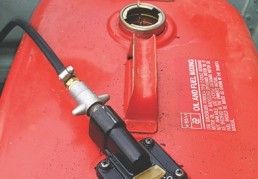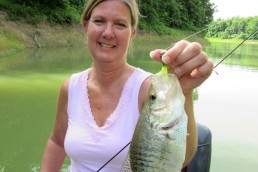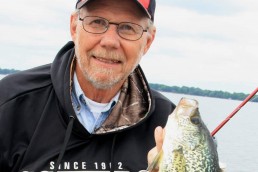Don’t be ‘Fuelish’: Secrets to Trouble-free Boating
SHARE THIS POST
The season opener coming soon signals the time for warmer weather, and biting fish—that is, if we can fire up the outboard.
Most boat problems are self-inflicted. The cause for breakdowns—not starting or not running smoothly—was explained recently by Pete Johnston, the service manager at Minnesota’s Bay Lake Marine.
“At least 90 percent of outboard problems are caused by fuel, and not treating it as the outboard’s lifeblood.”
The title of Johnston’s boating advice might be, “Don’t be Fuelish,” for at the Mercury Marine technical school instructors say gasoline is good for only two weeks.
“Storing a boat over the winter is more than two weeks,” Johnson said, regarding keeping fresh gas mandatory. “If followed, this alone would prevent most carburetor problems.”
He added this act keeps carbon buildup to a minimum.
“With every tank of gas, add fuel-system cleaner and stabilizer to two-stroke and four-stroke motors, new or old.”
His advice to those who don’t fish or boat often is even more critical.
“Buy only what you need; burn it up and add fresh next time out.”
Johnston said gas has 10 percent alcohol. Outboards have vented gas tanks unlike cars, which are sealed systems. The fuel system draws in outside air and moisture. Water and alcohol bond and sink to the bottom of the tank. With most alcohol out of the fuel, octane is lowered, making high-performance outboards especially vulnerable.
To keep people on the water, he equips every new boat—and those in for repairs—with a water-separating fuel filer. The fuel filter is mounted between the fuel tank and the outboard.
Are you enjoying this post?
You can be among the first to get the latest info on where to go, what to use and how to use it!
“You’d never want a big slug of water and alcohol to make it to your cylinders, or poof!” Johnston said.
Buy only oil with the same label as your outboard. Outboards operate at 5,000 to 6,000 RPMs when running down a lake; a truck runs about 2,000 RPMs. The right lubrication will keep an engine running longer. For those mixing gas and oil, Johnson said to follow instructions, never adding more oil than what is called for.
Check gaskets, trailer lights, the gas line and prop shafts too. Both Mercury and Yamaha tell customers to change fuel lines every three years. Oil filters should be changed every year, while a water pump impeller should be changed every three years. To check your water pump, back the boat into the water, start it (still on the trailer) and watch to see if it pumps at idle. Parts and labor vary for this, but without water flowing up and around the engine, the cost is a replacement of the entire powerhead, or even a new outboard. New plugs are always a good idea too, and it’s the first thing Johnston checks for when someone brings in a rough-running outboard.
The lower unit grease is another spring checklist item. If it looks cloudy or milky, have the dealer drain it, check and replace the leaking seal then re-fill the lower unit before you go fishing. Johnson suggests that anglers pull their props every month, check the shaft for fishing line, remove the line and replace the prop. Line can cut through the prop shaft seal.
Johnson offered one more in-season tip:
“Always trailer with outboards in as vertical a position as possible. It’s much easier on everything.”
George “Coop” Cooper, Brainerd-lakes legendary northern pike guide and lifelong mechanic, has worked on outboards forever. He’s also wrenched on train engines to cars to lawnmowers.
Before fishing this spring, check out Coop’s list of “must-do” items. His tips below could save you money and from embarrassment.
Check all boat and trailer electrical connections and lights.
- Clean terminals and fuse connectors with baking soda and water.
- Clean the battery case (top and sides).
- After drying, spray all electrical fittings with corrosion preventative.
- Make sure battery terminals are clean and coated.
- Check and clean all fuses, trailer light bulbs, receptacles and lights.
- Check trailer tire air pressure and the spare tire.
- Inspect wheel bearings; grease as necessary.
- Check lower unit lubrication.
- Clean boat and polish hull.
- Grease any outboard fittings.
- Tighten bolts, screws, lug nuts and trailer winch stand bolts.
- Lube any linkage, if accessible.
- Check manual and grease/lube starter shaft, if accessible.
- Check winch strap.
- Start, run, and then replace plugs.
- Check fire extinguisher.
- Check fuel lines and fuel primer bulb.
- Check PFDs and throw cushions.
- Add boat safety and fishing equipment.
- Check first-aid kit and update.
- Check tie lines, bow line and anchor line.
- Add a couple extra boat plugs this year.
- Inspect prop shaft for fishing line; grease if necessary.
- Add some extra fuses.
- Replace fuel.
- Make sure your boat and trailer meets all state licensing requirements.
MWO
SHARE THIS POST
Did you enjoy this post?
You can be among the first to get the latest info on where to go, what to use and how to use it!
Jim Kalkofen
Jim Kalkofen grew up with a fishing rod in his hands. After years in the PR game for Mercury and Mepps, he directed the Professional Walleye Trail. He and partners Al and Ron Lindner now provide weekly walleye and ice-fishing education and entertainment in Target Walleye/Ice, a free subscription email (targetwalleye.com). For more info: jim@targetwalleye.com or 651-356-5676.



